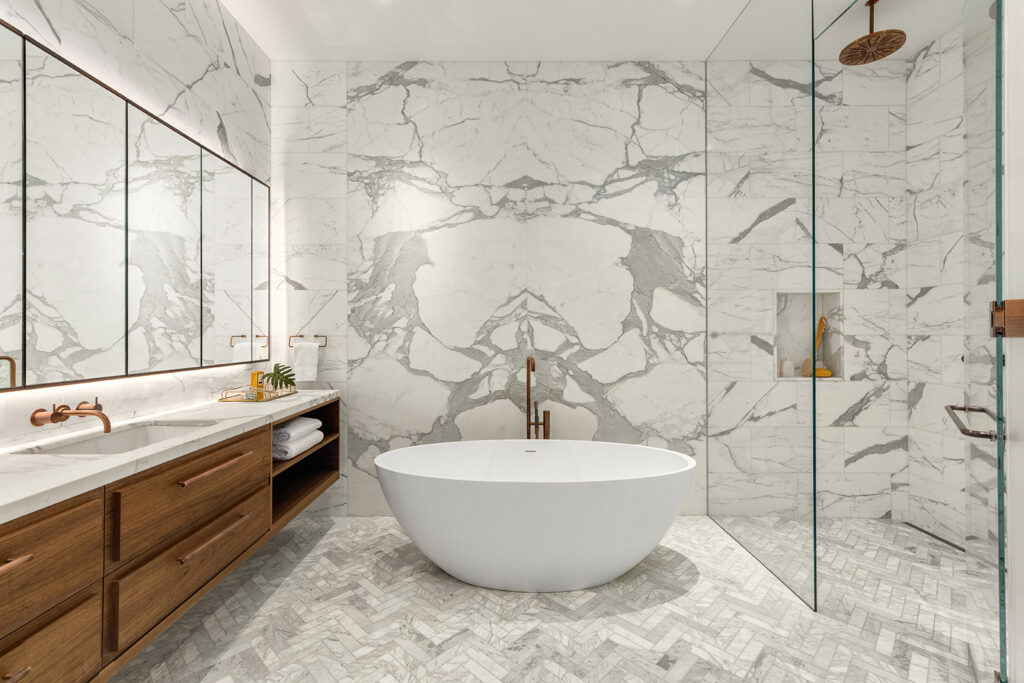
Where Can Young Americans Afford Their First Home? | 2025 Study
Nearly 75% of Americans under 30 cannot afford to buy a home in their current city, making location choice critical
Bathtub design has come a long way in recent years. Not only are modern bathtubs a luxurious and functional bathroom component, but they are also simply stunning. Hundreds of design possibilities exist, making the choice overwhelming at first. One of the first choices is between a freestanding bathtub and a built-in tub. Here’s what you need to know about these bathtub types.
You’re likely familiar with built-in bathtubs. Perhaps you have a built-in standard bathtub shower enclosure that you’d like to pull out and replace with something more sophisticated.
Source: Home Designing
A built-in bathtub is a part of the room’s architectural design. It is installed against a wall, or within an enclosure that is built into the room. The plumbing of a built-in tub is also part of the room’s design.
Source: HomeThangs
A drop-in bathtub is a built-in tub that is “dropped” into an enclosure. It features a deck and a finished surround.
While the standard built-in bathtub and shower enclosure may be a fixture in homes across the country, built-in bathtubs are not necessarily a boring choice. In fact, modern built-ins can be quite luxurious and gorgeous!
Space efficiency is a huge advantage for this type of bathtub. Built-ins, with their against-the-wall installation, make the best use of space. This space efficiency advantage can also be a disadvantage as you’re limited as to where you can install the built-in bathtub.
If you have a small bathroom with limited space to work with, a built-in bathtub with a shower enclosure is the most space efficient choice. Be aware, however, if you opt for a drop-in bathtub with a large deck and surround, it could take up as much space as a freestanding bathtub.
Another advantage with built-ins is that plumbing can be hidden within the surround or behind the wall as part of the construction process. This can also be a disadvantage if you later want to change your bathroom fixtures as you’ll be limited to the constraints of the existing plumbing.
Built-in bathtubs can be more difficult to clean than freestanding bathtubs, especially if you have a built-in bathtub/shower combination. Also, there aren’t all that many design choices in the built-in bathtub category as there are with freestanding bathtubs.
You’re also likely familiar with freestanding bathtubs such as the classic claw foot bathtub. Freestanding bathtubs have made a comeback, and while you can certainly find a freestanding bathtub with the vintage aesthetic, you’ll also find a large selection of modern freestanding bathtub designs offered in a variety of materials.
Source: Badeloft Freestanding Tub BW-03
A freestanding bathtub is exposed on all sides and can be placed virtually anywhere in a bathroom, assuming that all necessary plumbing is available or will be moved. Because they are not installed flush against a wall, they tend to take up more space than built-ins. However, if you have the space to spare, placing a freestanding bathtub in the bathroom can be a gorgeous choice. Plus, modern freestanding bathtub designs are incredible.
If you’re looking to create a focal point in your bathroom, a 60 inch freestanding bathtub can do it. Whether you prefer a sleek, clean, and minimalistic design or want a more traditional appearance, freestanding bathtubs are available to match any architectural style.
One of the disadvantages of freestanding tubs, plumbing, can also be seen as an advantage later. Initially, plumbing will need to be addressed. You may need to move the drain or have a plumber install the freestanding bathtub and its fixtures. However, once installed, should you later want to upgrade your freestanding bathtub fixtures, the installation will be much easier as you won’t need to tear into walls or enclosure.
In general, freestanding bathtubs are much easier to install than their built-in counterparts. While you do have plumbing to address, that’s about it. In contrast, a built-in tub may require a designer and a contractor — and a plumber. With a freestanding bathtub, you will likely only need the plumber’s help.
Freestanding bathtubs are also much easier to clean than built-ins because you can access the bathtub from all sides.
Adding a new bathtub to your bathroom can make a big impact on both the look of the room and your personal enjoyment of it. As you weigh the built-in vs. freestanding bathtub options, consider the room’s space, the pros and cons of each one, and your personal preferences. Which is best for you, a built-in tub or a freestanding bathtub?

Eric is the founder and president of Badeloft USA. He has been the president of Badeloft’s US division for over ten years and oversees all marketing and branding aspects of Badeloftusa.com.
His expertise lies in small business development, sales, and home and bathroom industry trends and information.
Contact us with any business related inquiries.

Free material samples and tub templates

Nearly 75% of Americans under 30 cannot afford to buy a home in their current city, making location choice critical

1 out of 5 Americans says they always feel rushed in their daily lives, yet finding cities that support a

When upgrading your bathroom, one of the most important—and often overlooked—decisions is choosing between a one-piece or two-piece toilet. While

Small details, including what you place on the floor, can make a big difference when setting up or upgrading your
Request your free material sample below. By submitting, you agree to receive occasional product updates and offers from Badeloft. Unsubscribe anytime.
"*" indicates required fields
"*" indicates required fields
"*" indicates required fields